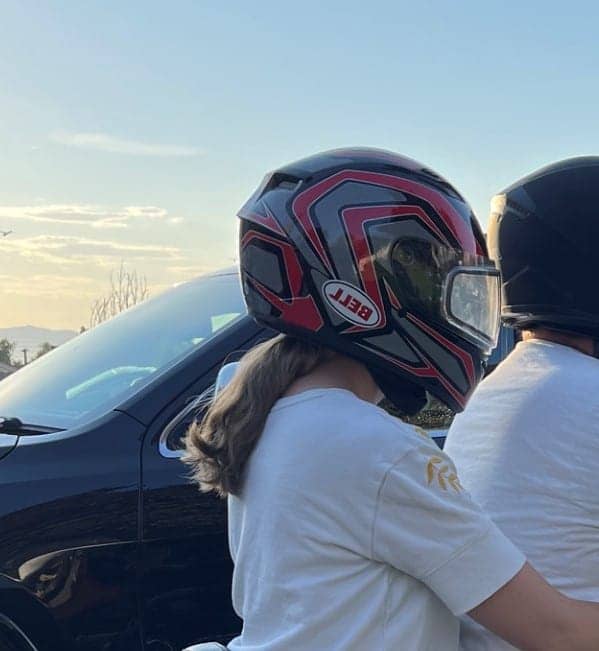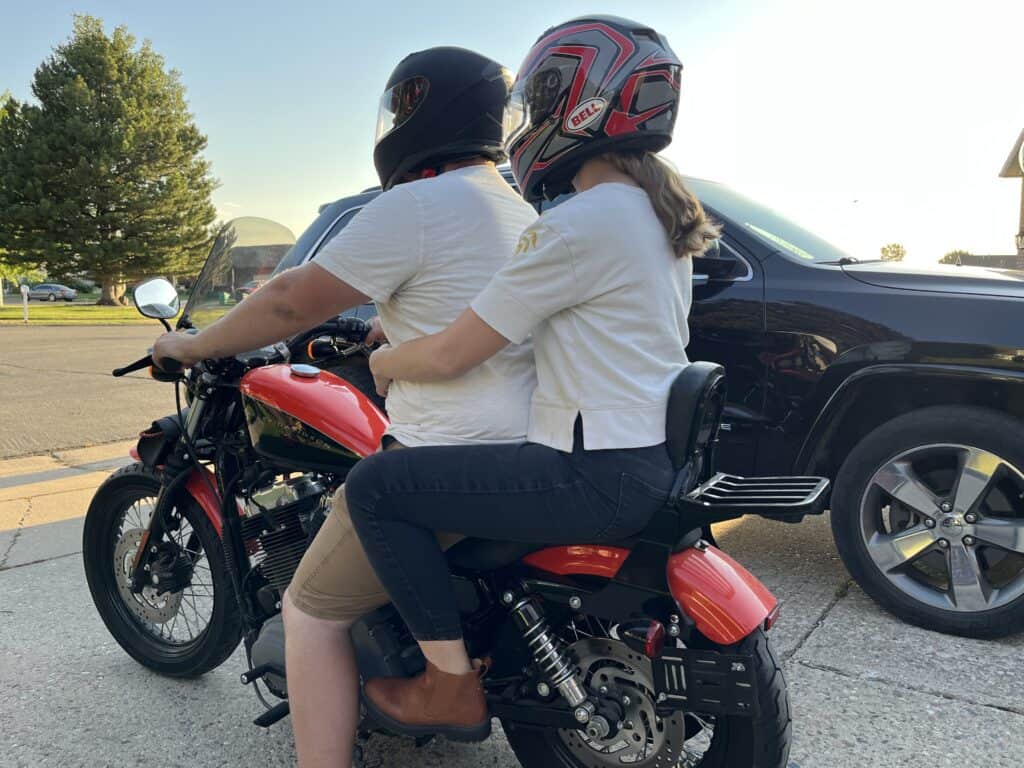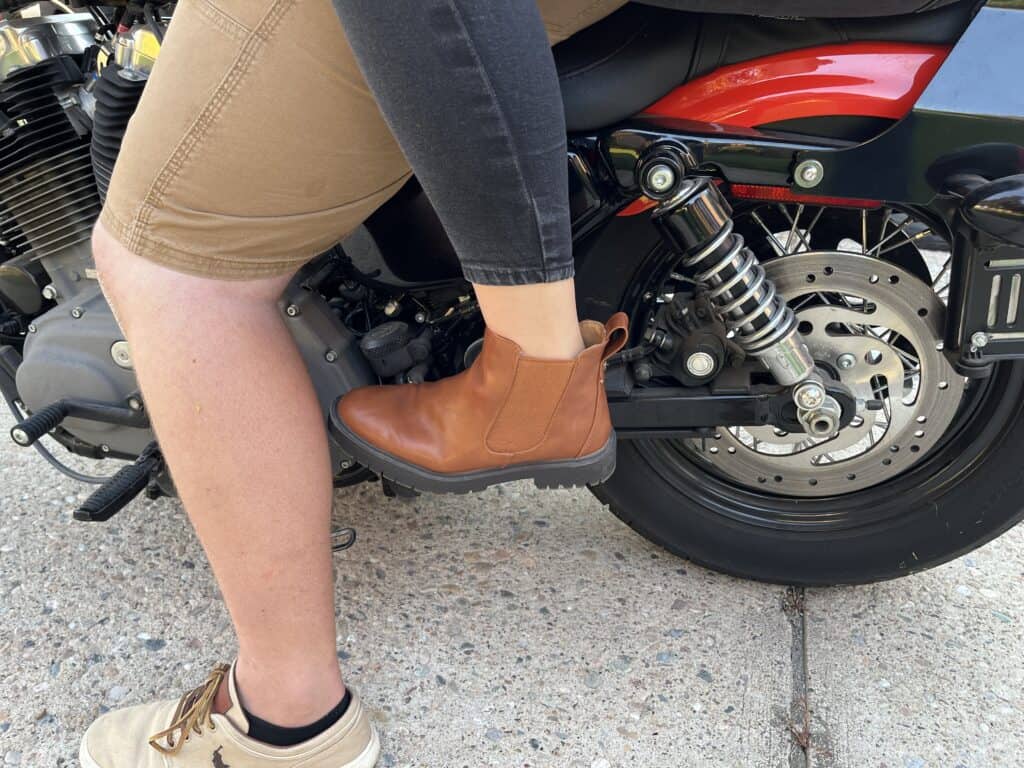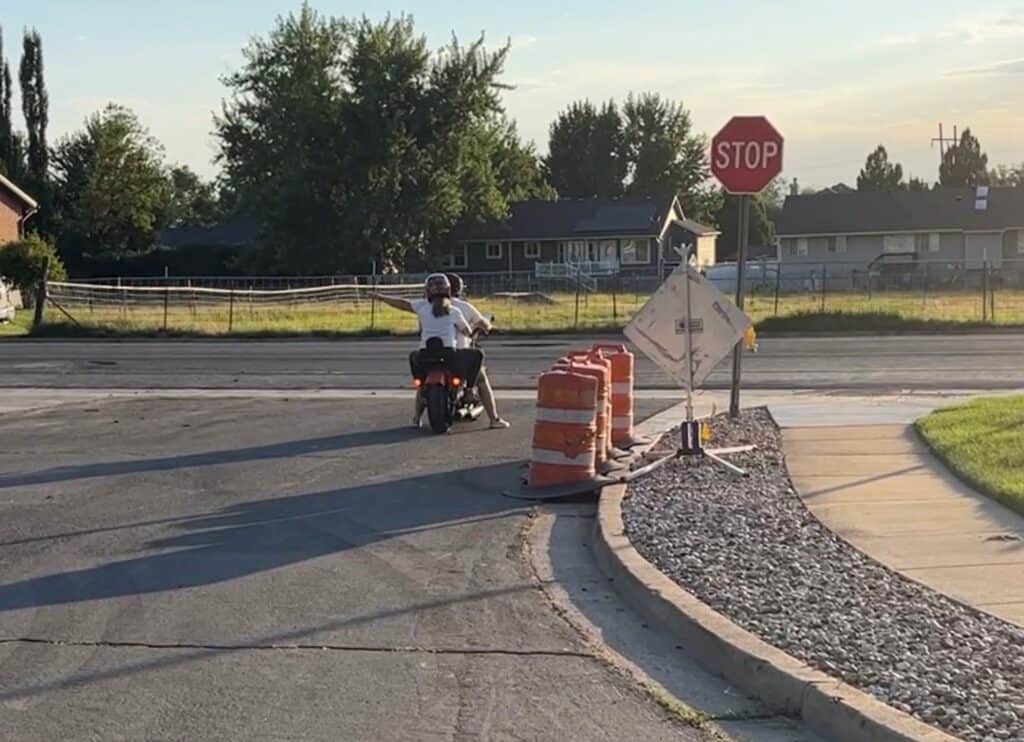
If you’ve ever had the chance to become a motorcycle passenger, you already know how fun and exhilarating it can be! I’ve had the chance to be both a motorcycle rider and a motorcycle passenger many times and I have a good idea of what it’s like in both positions. I also have a sense of what the motorcycle driver needs the passenger to understand and follow in order to have a safe ride.
I’ve taken my wife on hundreds of miles worth of rides while she got to sit behind me as a passenger. She and I were able to brainstorm and come up with some helpful tips and tricks to help a passenger know what to expect and how to act in order to be the best passenger possible.
1. Wear a Helmet
This is an obvious one, but you’d be surprised at how many passengers think they don’t need to wear a helmet. Helmets are just as important for passengers as it is for the driver.
Your helmet should fit snug around your head. If possible, wear a full face helmet for additional safety and security. If you plan on being a motorcycle passenger indefinitely, it may be a good idea to invest in a decent helmet fit specifically for you. Click here to see our article about the best budget-friendly motorcycle helmets for passengers.
If the person you plan to ride with does not have an extra helmet, or you can’t locate a spare helmet anywhere, do not ride the motorcycle at all. Or at the very least, if you are caught in a bind, the driver should be courteous enough to give you the one helmet and they go without; I know I would personally prefer my passenger to wear a helmet instead of me if we only had one at the moment. I don’t want their death and/or injury to be on my conscience.
It absolutely drives me crazy when I see a motorcyclist riding down the road with a passenger who has no helmet on. That passenger deserves better.
2. Wear a Jacket
If you’re planning on riding a motorcycle as a passenger, you should count on wearing some sort of jacket. The best type of jacket to wear while riding is a genuine leather jacket because studies have shown them be one of the best sources of protection in the case of an accident.
But if you’re a passenger, you may not have a leather jacket handy and your motorcycle partner may not have an extra one. If this is the case, try to find the thickest material jacket you have. If you happen to have a denim jacket, use that because it will be better than nothing.
You’ll need to at least wear some type of jacket because if you don’t wear any type of protection, you’ll further your chances of injury.
Again, if you plan on being a long-term motorcycle passenger, it’s probably a good idea to invest in a decent leather riding jacket.
3. Wear Ankle-Covering Shoes

Unfortunately, some of us learn this lesson the hard way. Let me save you from making this mistake and inform you that ankle-covering shoes are a must while riding a motorcycle, especially as a passenger.
Our ankle bones stick out a little and are susceptible to touching things our feet normally wouldn’t. When you’re riding a motorcycle as a passenger, your feet are right next to a tire that’s spinning thousands of times a minute. That can hurt a little (or a lot) if you get a little too close or if the wheel flips up a few rocks that hit your ankles.
Your feet are also very close to some very hot exhaust pipes. The last thing you want to do is burn yourself in the middle of a joy ride and have to cut your fun short. Those burns hurt!
If you have some heavy duty riding boots, that’s obviously perfect! I find that you don’t need to get too fancy with your shoes though, as long as the ankle covering is thick. My wife has some fashionable ankle boots that she’ll wear while we’re out for a ride and we’ve found those work great.
4. Wear Long Pants
Too many times I’ve seen men and women riding motorcycles with shorts on. Sometimes women even wear skirts (which I’m still trying to figure out how that even works). If you are planning on riding on the back of a motorcycle, you must always, always, always wear long pants.
Obviously, the most safe and protective type of pants you should wear are leather pants, but honestly most people never end up doing that (and to be completely honest I really hate how they feel while wearing them). Plan on at least wearing a good thick set of denim jeans.
The reason for wearing long pants while riding is pretty much the same reasons I stated for wearing ankle-covering shoes. Your feet and legs are by fast spinning tires and extremely hot pipes. Your legs do a lot for you, it would be wise to protect them as much as you can.
5. Don’t Wiggle
It’s extremely important to stay still while you’re riding as a motorcycle passenger. It’s easy to move around in any other type of vehicle with no consequences, but now you’re riding on just two wheels with someone else driving.
Any type of movement coming from you in the back will be unexpected to the driver. You don’t want to give the driver any surprises because that can lead to losing balance and in the worst case scenario, possibly tipping the motorcycle over.
During one of our rides, I was riding my motorcycle with my wife who was the passenger. I was taking a turn steering to the left while my wife wiggled a little bit to adjust herself which caused me to lose balance. Luckily we did not tilt, but it took me a good few seconds to regain the motorcycle’s composure.
It will often be difficult to not move around a lot, especially if you’re going for a long ride. Make sure that when you mount the motorcycle and begin your ride, you are in a comfortable position that won’t require much adjustment after a few minutes.
6. Sit Close To Your Driver
If you’re planning on being a motorcycle passenger, hopefully you are comfortable enough with the driver to be very close to them physically while going on a motorcycle ride.
It’s a good rule of thumb to get as close to the back of your driver as you can. You don’t need to be locked on to them, you just need to be close enough to be able to understand their body language such as how they lean during turns; this makes it easier to follow what they’re doing and may help you better react in the case of an accident.
It may take a few rides to figure out the right distance between you and the driver if you’re new to this kind of thing. Sitting close also helps with bonking and hitting helmets at stops. You’ll still probably bonk helmets, but when you sit close the distance to bonk isn’t near as big.
7. Be Prepared to Yell While Riding
Communication is difficult between driver and passenger while riding a motorcycle, unless of course you both have Bluetooth helmets. Don’t plan on saying much except maybe during stops. Trying to strike up a conversation in the middle of a ride is nearly impossible and incredibly frustrating for both parties.
But if you absolutely have something to say, you’ll need to speak up pretty loud because it’s really hard for a motorcycle rider to hear what you’re saying through a helmet that is covering your mouth, high winds, and a loud motor in the background.
If you must communicate while riding, keep your words to a minimum, such as “stop,” “turn,” or “hurting.” This will make it so much easier for you and the driver of the motorcycle and help make the trip much less frustrating.
8. Use Hand Signals
In case of any emergency while riding, yelling will probably be your go-to. But if you don’t want to have to yell at all during a motorcycle ride, using hand signals is an excellent way to communicate with your motorcycle driver.
Before you both get on the motorcycle and start riding, have a conversation about hand signals and what they indicate. There are universal hand signals fellow motorcyclists give to each other while on the road, but the two of you can come up with your own especially if you’re new to this.
Find hand signals to indicate that you need to stop, you’re tired, you’re doing okay, to go slower, or to go faster. Try not to come up with too many different types of hand signals because that can be difficult for both of you to remember. Try to stick with the basics.
One thing my wife and I always do is when I come to a stop light, I turn my head to indicate that I am asking if she is alright. She’ll usually give me a thumbs up to report she’s doing okay or a thumbs down which means we need to take a break (usually it’s thumbs up though). It’s convenient this way because her arms are wrapped my torso and her hands are already in front of me and easy for me to see.
9. Tie Your Hair Back

This is a good point my wife brought up because I don’t have long hair (and was unaware). Whether you are a man or a woman and have long hair, it’s most comfortable and safest to wear your hair in a pony tail, or at least have your hair tied back.
Sure, I get it. Wearing a helmet may not be the best for your hair style that day. My wife says that wearing her hair back while wearing a helmet helps keep her hair maintained a lot better than if she kept it loose.
Wearing your hair tied back also prevents your hair from creeping up to the front of your face and blocking your view. Even though you won’t be the one driving, it’s still incredibly annoying and can be unsafe if you can’t see where you’re at.
If you have longer hair but not long enough to put in a ponytail and still want to make sure it doesn’t get in your face, you can try using some hair pins, an elastic headband, or hairspray to ensure your hair stays in place while your helmet is on.
10. Go Where Your Driver Goes
You may notice while you’re riding that your driver tends to lean during turns. Whatever your driver does, you should do it too.
It’s important though to not do it too much; this can lead to imbalance of the motorcycle. Simply take your driver’s lead and do exactly as they do. This will help the two of you be more in sync and will provide a safer ride when the driver knows exactly what you’re doing.
Helping your motorcycle driver with leans assists the motorcycle itself to maintain stability and traction to the road. It’s important to not “fight” the lean, or move your body posture opposite to where the natural lean is in the turn. Try to keep your body centered with the center of the motorcycle.
If you’ve never been a motorcycle passenger before but are preparing to be one, don’t worry about this too much. Often this skill comes very naturally and hardly requires any second thought to be put into it.
11. Wrap Your Arms Around The Driver

As stated before, being a motorcycle passenger is a lot more comfortable if you are comfortable with the person driving the motorcycle. The best place to put your arms are around the driver; essentially you should hug them from behind.
If you aren’t that comfortable with the person you’re riding with, you can also place your hands on their hips, maybe grab on the belt loops of their pants. If the motorcycle you’re riding is a bit more luxurious, there may even be handle bars for your to grab onto made specifically for passengers. You should never hold on to the driver’s shoulders as that provides no grip and security for you.
Wrapping your arms around the driver helps you get as close to them as possible so you can better read their body language during stops and turns. And since the driver is holding on to the handlebars and you’re holding on to the driver, you can guarantee you won’t be going anywhere without the driver.
This is especially important if the motorcycle you’re riding does not have a back rest or back support to catch you. It can get a little scary when the driver takes off and gravity has it’s effect on you, pushing you back and almost pulling you off the back of the motorcycle. Hold on tight so that doesn’t happen. To learn more about how to hold on as a motorcycle passenger, you can read our other article that discusses this by clicking here.
12. You May Get a Little Itchy
This may sound odd, but it isn’t unheard of to get a little itchy while riding a motorcycle, especially if this is the first time you’re riding as a passenger.
It’s not a very common thing, but it’s common enough for me to hear about among several people, my wife included. The vibration of the bike has an effect on your body. If you have any parts of your body with poor circulation that is in direct contact with the motorcycle, that vibration stimulates circulation which can cause itching. Weird, right?
The most common places on the body for this to happen is the thighs and back which makes sense because the thighs are wrapped around the bike and the back is against the backrest. My wife reports that the back rest of motorcycles is usually what gets her and causes some itchiness in her back.
But don’t be afraid of this, it most likely won’t happen to you because it’s not common. But if it does, just be aware that you’re not going crazy. If it becomes too uncomfortable, inform your driver that you need to pull over and take a break, maybe even put some extra padding where it is needed.
13. You May Get a Few Cramps
If this is your first motorcycle rodeo, your body will not be used to sitting on a motorcycle seat. It may feel a little awkward the way you have to place your legs, depending on how the motorcycle was designed.
If you plan on doing a long trip, count on cramping up a little because sitting in one position for a long time in any case will cause such an outcome. If you’re worried about cramping, communicate with whoever you’re riding with and express your worries. They can give you some helpful tips about how to keep comfortable on their motorcycle specifically since they’ve had more experience on it.
It’s important to remember to not make sudden movements or adjustments if you do become stiff or cramp up while riding; this can cause some imbalance for the motorcycle driver. Let the person you’re riding with know that you need to pull over and do some stretches. Stretches before, during, and after will help circulation and prevent further cramping.
14. Help Direct The Driver
If you have a better idea of where you need to go and how to get to your destination, it’s helpful to assist the motorcycle driver with directions.
Riding a motorcycle is so fun, but sometimes it can get a little stressful for the person driving because extra safety precautions need to be made. You’re more susceptible to additional dangers while on a motorcycle, and with a passenger added to the equation, the driver should want to ensure the safety for both of you.
So giving a little extra assistance to the driver is always welcomed, even if you think they know where they’re going. You can do this by simply pointing your finger in the right direction; it’s convenient to do that anyway if your arms are wrapped around them.
15. Don’t Ride If There Aren’t Foot Pegs

You may be caught in an instance where there are foot pegs for the motorcycle driver, but none for the passenger. This may be simply due to the design of the motorcycle, or the owner took them off, or they for whatever reason fell off due to a hard hit, etc.
If you’re caught in this situation, do not ride the motorcycle. It is extremely dangerous to ride as a passenger on a motorcycle with no place to put your feet.
As stated before, your feet are very close to a tire spinning thousands of times a minute and some very hot pipes. Your feet just dangling around greatly increases your chances of foot and leg injuries. You’ll also not be able to brace yourself while slowing down and/or abruptly stopping.
You should never use or share foot pegs with the driver. The driver should always have a good foot grip to drive safely; sharing a foot peg with the driver can cause them to not be able to shift correctly (as the gear lever is usually located near the foot peg).
16. Wait Until The Driver Gets On
Sometimes there seems to be a little bit of confusion about who needs to get on the motorcycle first when there are two people involved. The motorcycle driver should always be the first to mount the motorcycle so they can steady it while the passenger gets on.
If the passenger were to get on first, it would be hard to steady the motorcycle because the handle bars are so far forward and out of reach. Simply balancing a motorcycle with your legs is extremely difficult and should never be done, especially by a passenger who is less likely experienced with motorcycles.
17. Be On The Lookout For Danger
I personally love having my wife ride with me as a passenger on my motorcycle. Not only do we get to be close and have fun together, but it’s nice knowing that she is providing an extra set of eyes to look out for potential hazards.
If you’re planning on being a motorcycle passenger, help your fellow rider out and be on the lookout for any potential danger around you. The one who is driving the motorcycle does their best to stay out of the way of any potential danger, but at the same time they need to keep their eyes on the road and watch where they’re going.
Be mindful of merging cars, upcoming stop signs or lights, pedestrians, etc. just as you would if you were the one driving. You have an advantage though because you get to keep looking from side to side and not worry about where you’re steering because someone else is doing it for you.
18. Brace Yourself When Stopping

As a motorcycle rider who has spent hundreds of hours riding with a passenger, I can’t tell you how much it helps to have the passenger help out a little when it comes to stopping. By this, I mean to try to not slam in to the back of them when you approach a stop.
As a passenger, it’s a big help to brace yourself when the motorcycle comes to a stop. This helps prevent the driver from scooting up too much and having to readjust, hopefully before you have to start going again. Bracing yourself will also help prevent helmet collision (which will probably happen anyway, but bracing yourself lessens the knock).
You can help brace yourself by leaning back just a little and pushing down on the foot pegs to prevent yourself from going forward so much. If you go forward some, that’s totally fine as you can’t always prevent momentum completely. Be mindful of stop lights and signs that are coming up so you can prepare yourself.
19. Let The Driver Know If You’re Uncomfortable
I would be lying if I said all motorcyclists are safe drivers. Sometimes when you’re on such an amazing machine you want to show off some of it’s potential. If you’re riding a motorcycle with someone, they may want to show off a little to you and expose what their motorcycle can do.
If you’re ever a passenger and become uncomfortable, whether that be due to the driver’s skills or some other reasons, you should tell your fellow rider that you’re uncomfortable and need to stop.
Riding a motorcycle is so much fun and you don’t want to ruin your experience by feeling uncomfortable while you’re riding. It’s okay to tell the driver to slow down or stop because you need to catch your breath. If they’re a decent person, they’ll follow your wishes.
20. Be Wary Of Who You Ride With
With that previous tip being said, if you are simply uncomfortable with the person you would be riding with, do not ride with them.
If you know they are a reckless driver, don’t take any chances with them. You have every right to say no to someone you’re uncomfortable with. Communicate with them what your expectations are when you’re riding a motorcycle. Follow your gut feeling; your gut tends to be right in situations like this.
21. Communicate With the Driver
All of this being said, the most important thing you can do while riding a motorcycle as a passenger is simply communicate with the person you are riding with. Be open about your fears, what you want to see/do, and what you expect from the experience.
The driver will be able to give you tips on how to be the most comfortable on their specific motorcycle. In most cases, the person you’re riding with will be appreciative of your communication and be open about their expectations as well.
Related Question
How should a passenger dismount a motorcycle? The passenger always dismounts the motorcycle first, then the driver. That way the driver can steady the motorcycle while the passenger dismounts. Depending on how big and tall the motorcycle is, using a foot stool can be helpful if handy. Otherwise, the passenger will need to steady themselves with one foot and swing the other leg over.
